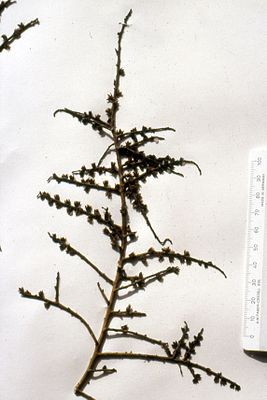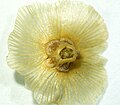Halothamnus somalensis
| Halothamnus somalensis | ||||||||||||
|---|---|---|---|---|---|---|---|---|---|---|---|---|

Halothamnus somalensis |
||||||||||||
| Systematics | ||||||||||||
|
||||||||||||
| Scientific name | ||||||||||||
| Halothamnus somalensis | ||||||||||||
| ( NEBr. ) Botsch. |
Halothamnus somalensis is a species of the genus Halothamnus inthe foxtail family ( Amaranthaceae ). It occurs in arid regions of East Africa (Djibouti, Somalia, Ethiopia) and is used in folk medicine.
description
Vegetative characteristics
Halothamnus somalensis grows as a shrub and reaches heights of 30 to 90 centimeters. The thorny, pointed, olive-green twigs turn black when drying. The semi-stemmed leaves that are pressed against the branches are linear with a length of only 0.5 to 3 millimeters.
Generative characteristics
The flowers are 3 to 4.7 millimeters in size. The winged fruit has a diameter of 8 to 12.5 millimeters, with the wings remaining light even on black plants. The pits on the underside of the fruit are line-shaped and border close to the surrounding wall, between them no nerves can be seen.
Anatomical features
In contrast to other Halothamnus species, the epidermis of the shoot axis of Halothamnus somalensis is cutinized in the outer walls and partly also in the radial walls .
Occurrence
Halothamnus somalensis is native to Djibouti , Somalia and arid regions of Ethiopia ; Similar plants from the Arabian Peninsula belong to Halothamnus bottae subsp. niger . The plants grow in open thorn savannah on sandy, loamy or rocky ground at altitudes between 0 and 1750 meters.
use
The roots of Halothamnus somalensis are traditionally used as a medicinal plant against parasitic worms in animals and humans.
Taxonomy
The first description of this species was in 1909 by Nicholas Edward Brown under the name Salsola somalensis . It was incorporated into the genus Halothamnus in 1981 by Victor Petrovič Botschantzev under the name Halothamnus somalensis .
Synonyms for Halothamnus somalensis (NEBr.) Botsch. are Salsola somalensis N.E.Br. , Salsola bottae (Jaub. & Spach) Boiss. var. faurotii Franchet and Salsola bottae (Jaub. & Spach) Boiss. var. farinulenta Chiov.
Common names
In Somalia, Halothamnus somalensis is known as "gosomadowbeye" ("gowsa-madobeyi", "goso-mudo-weyi", "gusomadobeye", "gosama do beya"), which is derived from the Somali words goso (= molar) and madow ( = black), and refers to the observation that the teeth and lips of grazing animals often turn black after they have eaten the plants. Other common names are "afmadobeye", "dankup", "mirrow", "mimou", or "mirgi-edalis". In Djibouti the species is also called "Yagali".
literature
- Gabriele Kothe-Heinrich: Revision of the genus "Halothamnus" (Chenopodiaceae) . In: Bibliotheca Botanica Vol. 143, Schweizerbart, Stuttgart 1993, ISBN 978-3-510-48014-2 , pp. 49-53: schweizerbart.de Schweizerbart Bibliotheca Botanica Vol. 143 website. (Sections Characteristics, Occurrences, Taxonomy)
Individual evidence
- ^ A b Gabriele Kothe-Heinrich: The genus Halothamnus (Chenopodiaceae) in Southwest Asia. In: Flora et Vegetatio Mundi 9, 1991, pp. 43-52.
- ↑ F. & M. Dawo Tibbo: anthelmintic effect of Halothamnus somalensis in Arsi-Bale goats . In: Livestock Research for Rural Development . Volume 17, Article # 68, 2005.
- ↑ Nicholas Edward Brown: Salsola somalensis NEBr. In: Bull. Misc. Inform. 2, 1909, p. 50 (first description)
- ^ Victor Petrovič Botschantzev: Revisio generis Halothamnus Jaub. et Spach (Chenopodiaceae) (Russian). In: Bot. Mater. Tanning Bot. Inst. Komarova Akad. Nauk SSSR = Novosti Sistematiki Vysshikh Rastenii. Moscow & Leningrad 18, 1981, p. 151. (New combination to Halothamnus )
- ↑ a b c d e Entry and herbarium evidence of Halothamnus somalensis at JSTOR
- ↑ a b G. Cufodontis: Enumeratio plantarum Aethiopiae. - Bull. Jard. Bot. État 23 (3/4) Suppl., 1953
- ↑ herbarium Hemming 1435 (Herbarium: K ex EA)
- ↑ herbarium specimens Chedeville 75 , Chedeville 216 (Herbarium: FT), Denis 79 (Herbarium: P)
Web links
- Halothamnus somalensis with distribution map , at African Plant Database

